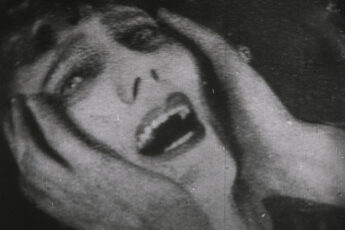The Metaphysics of Addiction or Vodka as a Truth
Wojchiech Jerzy Has’ The Noose (Pętla, 1957)
Vol. 47 (November 2014) by Pau Bosch Santos
Wojciech J. Has’ major themes and disenchantment with the world are already present in his first full-length feature. The Noose from 1957 was not a film the authorities could be fond of. It probably was, for them, nothing more than a morbid portrait of Post-War Poland. Marek Hłasko, author of the screenplay and of the novella that inspired it, was to be declared persona non grata in Poland soon thereafter, in 1958. As to Has, he was severely reprimanded by the critics, and never again made a film as grim and gloomy and as devoid of humor.
The plot is brutally stark. Kuba is an alcoholic who wants to quit drinking. He is unable to, so he hangs himself. The character is equally schematic. All we know is that Kuba’s got a girlfriend who cares for him and wants to help him out; that he has quite a lot of busybody acquaintances whom he can barely stand; and that he once had a boyhood love that didn’t work out. We know nothing about his job (if he has one) or his hobbies (if he has any besides boozing). Kuba’s only obsession is time. He’s scared of time, he says at some point. He only wants to forget and be forgotten. His only desire is that the hours separating him from Krystyna’s coming back and getting him the pills that are going to help him out of his inferno — that those hours pass as fast as possible.
Such an uneventful plot and such a boring character all point to one thing: Kuba’s life is unimportant. At issue here is not Kuba’s personal history, nor merely the sordid portrait of a hopeless society, but first and foremost the metaphysics of addiction in their relation to time. It is no coincidence that the film takes the form of a race against the clock — what we witness are the last twenty-four hours in the life of Kuba. But Kuba is not the only one to be terrified by time. Once and again we see people asking, or announcing in boredom, what the time is. The very opening of the film provides its quintessence: as Kuba hears the church bells, he approaches the window and looks anxiously at a street clock which is apparently slow. Krystyna was supposed to be there at eight. But she knocks at the door only and precisely when the two operators reset the street clock to eight.
The time Kuba (and everyone else in the film) lives by, then, is the reified time of clocks. Walter Benjamin famously characterized it as “homogeneous and empty time,”1 that is, as being conceived of something like a line made up of abstract instants stretching to no end. The hell Kuba and his bored fellow citizens are trapped in is that of a time that is like a slow death. Thus Kuba counts down every minute he spends without drinking, and adds them up till it’s unendurable. There’s a passage in David Foster Wallace’s Infinite Jest (which is itself a gargantuan reflection on addiction) that will allow us to picture both Kuba’s suffering and his conception of time. In it, a character compares her struggle to stay clean with the dare-devil Evel Knievel’s car jumps: “As if each day was a car Knievel had to clear. One car, two cars. By the time I’d get up to say maybe about 14 cars, it would begin to seem like this staggering number. Jumping over 14 cars. And the rest of the year, looking ahead, hundreds and hundreds of cars, me in the air trying to clear them.”2
To Benjamin and Foster Wallace, hope can only be found in what they call the Now or the Present. To Foster Wallace, the key to stay clean is to abide by the present and thereby realize that no one single instant is in itself unendurable. Benjamin talks about the “time of the now” (Jetztzeit), which he identifies with the constructive time of remembrance: a time that, as he puts it, “is shot through with chips of Messianic time”3 (i.e. the moment you awaken the dead by understanding your fight is not different from theirs and by fulfilling the unrealized possibilities of the past).
There is no such gleam of hope in Wojciech Has’ film. Not even once in the whole film we hear Kuba saying that he is going to do this or that by himself in order to get out of his mess. He passively awaits redemption to come from a higher instance: either Krystyna or the pills or the doctors. This is roughly how he reasons: to be able to get hold of his life, he first needs to free himself from the substance that has gotten hold of him; but since as a slave he lacks the power to get rid of the tyrant, salvation must come from the outside. He thus commits the fallacy of the conformist: to think that he cannot fight because he is subdued (whereas he’s subdued in the first place precisely because he doesn’t fight).
Maybe Kuba started drinking because he couldn’t or didn’t want to face his problems, but the sad truth of substances is that at some point vodka became his one and only problem. Since he has recognized that, Kuba doesn’t drink to forget, as the saying goes. What he’d like to forget is that he once drank: “There’s no such bad luck, no loneliness, no woman, for whom it’s worth to drink. But only those who lost all to drinking know it. Those who have to drink. Those who start drinking have no idea. Vodka is a truth one always understands when it’s too late.”
But because Kuba wants no regrets, because he only dreams of sweeping his past away, because there is nothing in his past that he would learn from, he is incapable of building a future. Together with time, he has reified himself. That’s why his personal history is unimportant. Instead of a subject, he stands in just for the addict. As an addict, he is a puppet doomed to mechanically repeat the same gestures over and over, till they’re not only meaningless but nightmarish. Thus, at the beginning of the film we see Kuba replacing the broken glass from a picture lying on the floor, and then, towards the end, when he wakes up in the middle of the night with a hangover, we see him stepping on the new glass in the morning and breaking it. Also the drunkard he meets at the police station repeats the same ritual every day, and the desperate officer knows it ad nauseam.
As an addict, too, he is indistinguishable from other addicts. They’re all copies taken out of the mold of vodka. The drunkard he meets in a bar he rightly identifies at first sight as his own double and calls him Kowalski, which is his own name. He indeed is his double coming right from the future to wipe out Kuba’s last hope. Hospitals, doctors, pills, even caring girlfriends are of no use, he tells Kuba, they only add up to the suffering. The only way out is to turn into a pile of rotten meat.
When Kuba finally hangs himself, he uses the telephone cable as a rope. As a final symbol of his failure to communicate, he shuts down the line through which all the urgings, admonishments, regrets were coming in.
Has’ vision is unrelenting. We don’t know whether he intended the addict (i.e. the passive subject whose only hope is to be rescued by some external higher power) to be some kind of metaphor for Polish society (Communism as the Substance?). In any case, one can understand that the authorities were alarmed by such a bleak picture of their society. The saddest thing is that Has’ and Hłasko’s alarm call was to prove somewhat prophetic. In a review on alcohol consumption in Poland between 1950 and 2005 we see that spirits consumption, which had reached a historical peak in 1956 (the year of the publication of Hłasko’s novella), had literally doubled by 1980 (from four to eight liters per capita per year).4




Leave a Comment